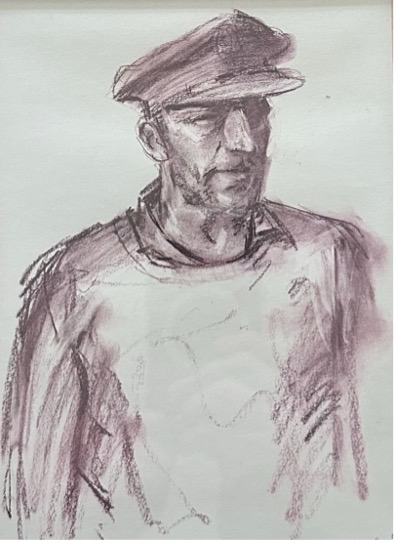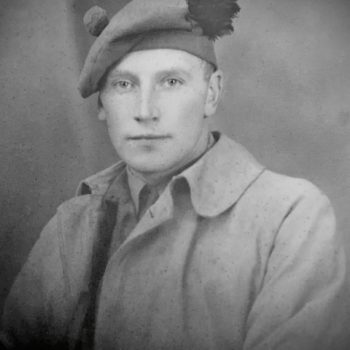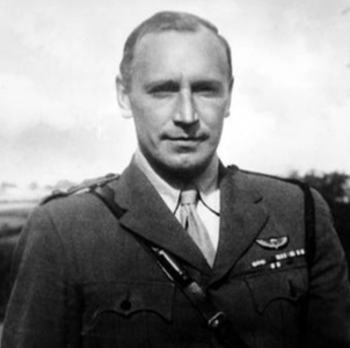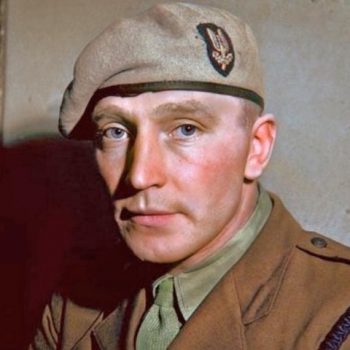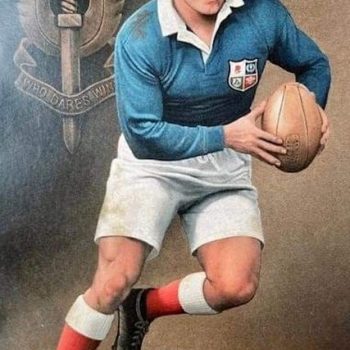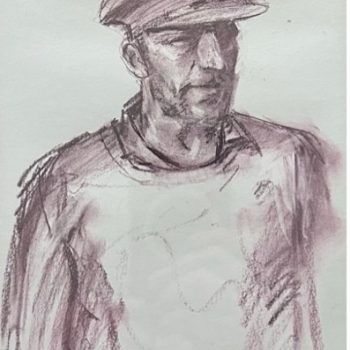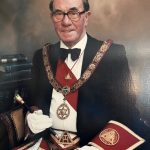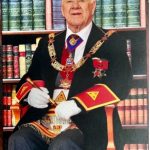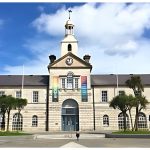Although many Masons from Newtownards and Lodge 447 served their country and fought in various wars and conflicts, none were more prolific than Lt. Col. Robert Blair Mayne. Sometimes known as Colonel Paddy. His military escapades and honours are well known all over the world.
Robert Blair “Paddy” Mayne was born on 11th January 1915, five months after the start of World War I in Newtownards, County Down. He was the son of William Mayne and Margaret Boyle Vance. Margaret Boyle Vance was born in Holywood, Northern Ireland and died on the 25th February 1956 in Newtownards. Margaret’s family originally came from Cumberland. Her grandfather, Gilbert Vance, was a linen merchant in Belfast. Margaret, who was described as ”a strong determined woman”, was alive in 1955 at the time of her son Robert Blair’s death. Throughout his life it was always to her that he turned for support.
William Mayne was from a Presbyterian family who had come originally from Scotland and settled in Northern Ireland early in the 18th century. John Echlin Mayne, was born in 1781 on the Strangford Peninsula, of a Scottish Presbyterian family, who it is said was established there for a hundred years. It is not known which part of Scotland they originally came from.
Robert Blair Mayne was one of seven children, with two older brothers, Thomas and William, a younger brother, Douglas, and three sisters, Molly, Barbara and Frances.
His great grandfather, William Mayne, established the family home, known as Mount Pleasant, in Newtownards and began a wine and grocery business there, which was still flourishing when Blair was a boy. The business had passed to his grandfather, Thomas and on to his father, William. His father was a successful businessman, owning property and running a retail business in Newtownards who continued to live at Mount Pleasant, a property set in around 41 acres of grounds overlooking the town. The property is no longer in the ownership of the Mayne family. It has been developed in recent years as a housing development.
He attended Regent House Grammar School. It was there that his talent for rugby union became evident, and he played for the school 1st XV and for the local Ards RFC team. While at school he also played cricket and golf and showed aptitude as a marksman in the rifle club.
On leaving school he studied law at Queen’s University of Belfast, studying to become a solicitor. While at university he took up boxing, becoming Irish Universities Heavyweight Champion in August 1936. He followed this by reaching the final of the British Universities Heavyweight Championship but was beaten on points. With a handicap of 8, he won the Scrabo Golf Club President’s Cup the next year.
Mayne’s first full Ireland rugby cap also came in 1937, in a match against Wales. After gaining five more caps for Ireland as a lock forward, Mayne was selected for the 1938 British Lions tour to South Africa. While the Lions lost the first test, a South African newspaper stated Mayne was “outstanding in a pack which gamely and untiringly stood up to the tremendous task“. He played in seventeen of the twenty provincial matches and in all three tests. On returning from South Africa, he joined Malone RFC in Belfast.
Mayne won praise during the three Ireland matches he played in 1939, with one report stating
“Mayne, whose quiet almost ruthless efficiency is in direct contrast to O’Loughlin’s exuberance, appears on the slow side, but he covers the ground at an extraordinary speed for a man of his build, as many a three quarter and full back have discovered.“
In March 1939, prior to the outbreak of World War II, Mayne had joined the Territorial Army in Newtownards. After training with the Queen’s University Officer Training Corps, he received a commission in the 5th Light Anti-Aircraft Battery, Royal Artillery. In April 1940 he transferred to the Royal Ulster Rifles. Following Churchill’s call to form a “butcher and bolt” raiding force following Dunkirk, Mayne volunteered for the newly formed 11 (Scottish) Commando. He first saw action in June 1941 as a lieutenant with 11 Commando, successfully leading his men during the Litani River operation in Lebanon against the Vichy French Forces
It was after this particularly brutal and confused action, in which 130 officers and men, around a third of the strike force, were wounded or killed, that Mayne reacted violently against what he believed was the ineptitude of his Commanding Officer, whom he considered inexperienced, arrogant and insincere. Some sources state that Mayne struck him and was awaiting court-martial and almost certain dismissal.
Captain David Stirling noticed his leadership during the raid and recruited him as a founding member of the Special Air Service (SAS). From November 1941 to late 1942, Mayne took part in numerous night raids behind enemy lines in Egypt and Libya, where the SAS destroyed hundreds of German and Italian aircraft on the ground.
After Stirling was captured in January 1943, the 1st SAS Regiment split into the Special Raiding Squadron and the Special Boat Section. Major Mayne led the Special Raiding Squadron in Italy until late 1943 and then became Lieutenant Colonel and commanding officer of the 1st SAS Regiment in January 1944. He led the SAS through campaigns in France, Holland, Belgium, Germany, and Norway, often working with local resistance fighters like the French Maquis.
For his leadership and bravery in France, where he collaborated with the French Resistance, Mayne earned a second bar to his DSO. The post-war French Government also awarded him the Legion d’Honneur and the Croix de Guerre, making him the first foreigner to receive both honours.
During World War II, he became one of the British Army’s most decorated soldiers, earning the Distinguished Service Order with three bars, a distinction held by only seven servicemen. Mayne innovated the use of military Jeeps for surprise raids on enemy airfields, reportedly destroying 130 aircraft by the war’s end.
Mayne was not awarded a Victoria Cross, despite even King George VI expressing surprise. This likely stemmed from his abrasive attitude towards some superiors and the Army’s view of special forces’ unconventional tactics.
In 1945, Mayne was recommended for a VC after rescuing his squadron near Oldenberg, Germany. Under heavy gunfire, he lifted wounded soldiers into his Jeep and destroyed enemy gunners in a farmhouse. Although Field Marshal Montgomery considered signing the recommendation, Mayne received a fourth DSO instead.
After working with the British Antarctic Survey in the Falkland Islands, which was cut short by a back injury from his army days, Mayne returned to Newtownards. There, he worked as a solicitor and later as Secretary to the Law Society of Northern Ireland. He suffered severe back pain, making it difficult for him to watch rugby and cope with the mundane post-war life. This led to his isolation and reluctance to discuss his wartime service.
Blair Mayne, along with his younger brother Douglas, joined the Masonic Order, following in the footsteps of their father who became a member in 1904. Blair Mayne’s membership in the Order was delayed due to World War II, resulting in him joining one of his father’s former Lodges two years after his father’s death.
Robert Blair Mayne joined Eklektikos Lodge No. 542 in Newtownards on 25th September 1945. He received his second degree on 28th May 1946 and his third degree on 24th September 1946. In 1954, he was elected as Worshipful Master.
Upon joining the Lodge, his profession was listed as ‘Army’. Starting from February 1948, he was also a member of Friendship Lodge No. 447 in Newtownards, where his profession was recorded as Solicitor.
Blair was an active participant in Freemasonry, valuing both the camaraderie and the company of his fellow masons. He regularly attended Lodge meetings upon his return to Newtownards after the war and his expeditions to Antarctica.
On 14th December 1955, at Mill Street in Newtownards while returning from Bangor, Blair passed away around 4am. Earlier that evening, he had attended a meeting of Friendship Lodge No.447 in Newtownards Masonic Hall, joined friends for drinks in Newtownards, then went to the Bangor British Legion for more drinks. Unfortunately, he was involved in a car accident on Mill Street, Newtownards.
Blair’s red Riley sports car, nicknamed “Red Rocket” or “Big Red Fire Engine,” collided with a stationary truck and hit a wooden electricity pole, resulting in a fatal skull fracture. His funeral was the largest Newtownards had ever seen, with a mile-long cortege taking an hour to pass through the town. He is buried in the Mayne Family plot at Movilla Abbey Cemetery.
